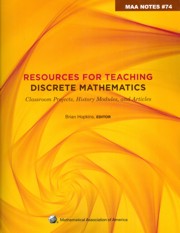Book contents
- Frontmatter
- Introduction
- Dedication
- Contents
- I Classroom-tested Projects
- II Historical Projects in Discrete Mathematics and Computer Science
- Introduction
- Binary Arithmetic: From Leibniz to von Neumann
- Arithmetic Backwards from Shannon to the Chinese Abacus
- Pascal's Treatise on the Arithmetical Triangle: Mathematical Induction, Combinations, the Binomial Theorem and Fermat's Theorem
- Early Writings on Graph Theory: Euler Circuits and The Königsberg Bridge Problem
- Counting Triangulations of a Convex Polygon
- Early Writings on Graph Theory: Hamiltonian Circuits and The Icosian Game
- Are All Infinities Created Equal?
- Early Writings on Graph Theory: Topological Connections
- A Study of Logic and Programming via Turing Machines
- Church's Thesis
- Two-Way Deterministic Finite Automata
- III Articles Extending Discrete Mathematics Content
- IV Articles on Discrete Mathematics Pedagogy
- About the Editor
Early Writings on Graph Theory: Euler Circuits and The Königsberg Bridge Problem
from II - Historical Projects in Discrete Mathematics and Computer Science
- Frontmatter
- Introduction
- Dedication
- Contents
- I Classroom-tested Projects
- II Historical Projects in Discrete Mathematics and Computer Science
- Introduction
- Binary Arithmetic: From Leibniz to von Neumann
- Arithmetic Backwards from Shannon to the Chinese Abacus
- Pascal's Treatise on the Arithmetical Triangle: Mathematical Induction, Combinations, the Binomial Theorem and Fermat's Theorem
- Early Writings on Graph Theory: Euler Circuits and The Königsberg Bridge Problem
- Counting Triangulations of a Convex Polygon
- Early Writings on Graph Theory: Hamiltonian Circuits and The Icosian Game
- Are All Infinities Created Equal?
- Early Writings on Graph Theory: Topological Connections
- A Study of Logic and Programming via Turing Machines
- Church's Thesis
- Two-Way Deterministic Finite Automata
- III Articles Extending Discrete Mathematics Content
- IV Articles on Discrete Mathematics Pedagogy
- About the Editor
Summary
In a 1670 letter to Christian Huygens (1629–1695), the celebrated philosopher and mathematician Gottfried W. Leibniz (1646–1716) wrote as follows:
I am not content with algebra, in that it yields neither the shortest proofs nor the most beautiful constructions of geometry. Consequently, in view of this, I consider that we need yet another kind of analysis, geometric or linear, which deals directly with position, as algebra deals with magnitude.
[1, p. 30]Known today as the field of ‘topology,’ Leibniz's study of position was slow to develop as a mathematical field. As C. F. Gauss (1777–1855) noted in 1833,
Of the geometry of position, which Leibniz initiated and to which only two geometers, Euler and Vandermonde, have given a feeble glance, we know and possess, after a century and a half, very little more than nothing.
[1, p. 30]The ‘feeble glance’ which Leonhard Euler (1707–1783) directed towards the geometry of position consists of a single paper now considered to be the starting point of modern graph theory. Within the history of mathematics, the eighteenth century itself is commonly known as ‘The Age of Euler’ in recognition of the tremendous contributions that Euler made to mathematics during this period. Born in Basel, Switzerland, Euler studied mathematics under Johann Bernoulli (1667–1748), then one of the leading European mathematicians of the time and among the first – along with his brother Jakob Bernoulli (1654–1705)–to apply the new calculus techniques developed by Leibniz in the late seventeenth century to the study of curves.
- Type
- Chapter
- Information
- Resources for Teaching Discrete MathematicsClassroom Projects, History Modules, and Articles, pp. 197 - 208Publisher: Mathematical Association of AmericaPrint publication year: 2009
- 5
- Cited by



